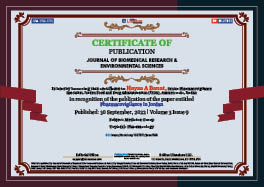Medicine Group . 2022 September 30;3(9):1128-1129. doi: 10.37871/jbres1566.
Pharmacovigilance in Jordan
Hayaa A Banat*
Jordan Food and Drug Administration (JFDA) is an independent institution responsible for protecting the Jordanian public health through ensuring the safety, efficacy, and security of medicines and health technologies, as well as ensuring the safety of the food supply reaching consumers in Jordan. (JFDA) was formally established in 2003 in order to address scientific and global developments in food & drug control in the Hashemite Kingdom of Jordan. In its first decade, the JFDA has implemented its role as a national competent authority for food and drug control, but it becomes the national Jordanian agency empowered to develop and implement harmonized standards, and lead cooperation and development programs through agreements with national, regional and international companies and institutions. Drug Directorate in (JFDA) is responsible for the full lifecycle of medicines starting from Active Pharmaceutical Ingredient (API) until it is formally authorized as a Finished Product to be used in markets. This lifecycle starts from (i) product registration; (ii) pricing; (iii) accreditation of pharmaceutical manufacturers; (iv) promoting Rational Drug Use (RDU); and (v) Pharmacovigilance (PV)
Because of the importance of Pharmacovigilance in improving patient care and public health, encouraging the safe, rational and more effective (including cost effective) use of medicines, and detecting problems related to the use of medicines, Pharmacovigilance system was established in Jordan in 2001. Pharmacovigilance was first practiced as part of the registration department in the drug directorate, to become lately a full dedicated department called (Rational drug and pharmacovigilance department) on February 2014.
Pharmacovigilance History in Jordan:
- Jordan became a full member by the World Health Organization (WHO) Collaborating Centre for International Drug Safety Monitoring, The Uppsala Monitoring Centre (UMC) in 2002.
- In 2006, was the first approval of adverse drug reactions guidelines based on the ICH- Guidelines, which clarify the relation among stakeholders (Health authorities, healthcare providers, industry and patient)
- In 2010, the guidelines were updated according to JFDA/PV post marketing practical experience in Jordan. to be updated then in 2010 and last update in 2016 to be in line with the Arab GVP guidelines.
- The Arab Good Pharmacovigilance Practice (GVP) Guidelines came out in March 2013 and then updated in July 2015.
- Between (2011-2015) five Pharmacovigilance regional centres have been established in the north, middle and south of Jordan to increase the awareness about Pharmacovigilance and promote reporting of ADRs.
- Lately, in September 2022 the sixth regional centre has been established in Royal Medical Services.
Accordingly, and based on regulations and guidelines, many activities related to pharmacovigilance are performed by the PV team in JFDA to ensure safe, effective and rational use for the medicines are used in Jordan; activities in relation with the Marketing Authorization Holder (MAH) of the medicinal products to ensure their compliance with the effective guidelines and regulations including: (i) ensuring the assignment of fully dedicated qualified person for pharmacovigilance, (ii) monitoring safety database including all possible adverse drug reactions and quality complains of their products, (iii) performing inspection on their quality management system; and (iv) following-up the update of all safety requirements of the products. Other activities of the (PV) team including but not limited to: (i) detection, collection and assessment of adverse drug reaction reports and sending them to the global database (UMC); (ii) promoting understanding, education and clinical training in pharmacovigilance and its effective communication to public; (iii) maintaining the medicinal products insert leaflets updated with the most updated safety information; (iv) assessment of the Risk Management Plans (RMP) and Periodic Safety Update Reports (PSUR); (v) building database for the Additional Risk Minimization Measures (ARMMs) for the authorized products intended to prevent or reduce the occurrence of adverse reactions associated with the exposure to a medicine, or to reduce their severity or impact on the patient; (vi) initiating local Additional Monitoring List (AML) which is a list includes medicines authorized in Jordan that their safety is being monitored intensively and closely, (vii) strengthening building capacity of pharmacovigilance for all healthcare professionals, and (viii) circulating drug safety communication letters continuously to all health bodies in the country which was 24, 26, 13 and 22 respectively for the years from 2018 to 2021.
Health Hazard Evaluation Committee (HHEC) a committee includes members from internal JFDA pharmacovigilance specialists in addition to external highly qualified specialists from academia and clinical practice areas was formed to include the following Terms of Reference but not limited to:
Providing scientific advice on current and emerging issues related to registered drugs used in Jordan; Evaluating safety, quality, and efficacy issues of registered drugs. Such evaluation will be based on information provided to the Committee, knowledge of drug literature, expertise and experience of members; Providing recommendations to JFDA to appropriate regulatory actions related to the safety, quality, and efficacy; Assessing safety issues related to drug use including misuse, abuse or off-label use, and recommending actions to be taken by JFDA; Carrying out assessments including causality assessments of Adverse Drug Reaction (ADR) reports; Recommending interventions and activities that will enhance professional and consumer awareness of safety, quality, and efficacy issues related to the use of drugs.
So, Pharmacovigilance is an important regulatory function to ensure that the benefits of a medical product continue to outweigh the risks when used by the patients, and maximize efforts to raise the awareness and knowledge of healthcare professionals as well as public behaviour about PV and to promote ADR reporting in Jordan.
Content Alerts
SignUp to our
Content alerts.
 This work is licensed under a Creative Commons Attribution 4.0 International License.
This work is licensed under a Creative Commons Attribution 4.0 International License.








